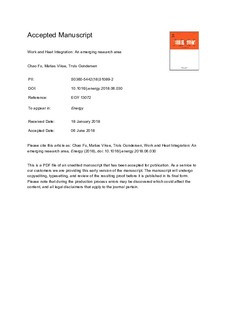| dc.contributor.author | Fu, Chao | |
| dc.contributor.author | Vikse, Matias | |
| dc.contributor.author | Gundersen, Truls | |
| dc.date.accessioned | 2018-07-11T07:39:08Z | |
| dc.date.available | 2018-07-11T07:39:08Z | |
| dc.date.created | 2018-06-12T10:51:48Z | |
| dc.date.issued | 2018 | |
| dc.identifier.issn | 0360-5442 | |
| dc.identifier.uri | http://hdl.handle.net/11250/2505107 | |
| dc.description.abstract | The extension from Heat Integration (HI) and design of Heat Exchanger Networks (HENs) to including heating and cooling effects from pressure changing equipment has been referred to as Work and Heat Integration and design of Work and Heat Exchange Networks (WHENs). This is an emerging research area of Process Synthesis, however, WHENs is a considerably more complex design task than HENs. A key challenge is the fact that temperature changes (related to heat) and pressure changes (related to work) of process streams are interacting. Changes in inlet temperatures to compressors and expanders resulting from heat integration will influence work consumption and production. Likewise, pressure changes by compression and expansion will change the temperatures of process streams, thus affecting heat integration. As a result, Composite and Grand Composite Curves will change shape due to pressure changes in the process. The thermodynamic path of process streams from supply (pressure, temperature) to target state is not known and depends on the sequence of heating, cooling, compression and expansion. This paper introduces a definition and describes the development of WHENs. Future research challenges related to methodology development and industrial applications will be addressed. The potential of WHENs will be indicated through examples in literature. | nb_NO |
| dc.language.iso | eng | nb_NO |
| dc.publisher | Elsevier | nb_NO |
| dc.rights | Attribution-NonCommercial-NoDerivatives 4.0 Internasjonal | * |
| dc.rights.uri | http://creativecommons.org/licenses/by-nc-nd/4.0/deed.no | * |
| dc.title | Work and Heat Integration: An emerging research area | nb_NO |
| dc.type | Journal article | nb_NO |
| dc.type | Peer reviewed | nb_NO |
| dc.description.version | acceptedVersion | nb_NO |
| dc.source.journal | Energy | nb_NO |
| dc.identifier.doi | 10.1016/j.energy.2018.06.030 | |
| dc.identifier.cristin | 1590636 | |
| dc.relation.project | Norges forskningsråd: 257632 | nb_NO |
| dc.description.localcode | © 2020. This is the authors’ accepted and refereed manuscript to the article. Locked until 7.6.2020 due to copyright restrictions. This manuscript version is made available under the CC-BY-NC-ND 4.0 license http://creativecommons.org/licenses/by-nc-nd/4.0/ | nb_NO |
| cristin.unitcode | 194,64,25,0 | |
| cristin.unitname | Institutt for energi- og prosessteknikk | |
| cristin.ispublished | true | |
| cristin.fulltext | postprint | |
| cristin.qualitycode | 2 | |

